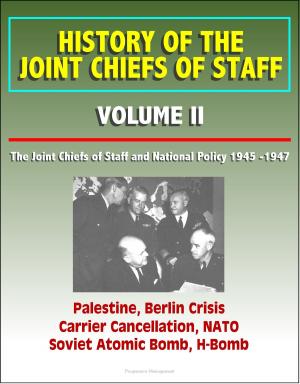U.S. Decision Making and Post-Cold War NATO Enlargement: Collapse of Soviet Union, Opposition of Russia and Putin, Controversy Over Macedonia, Montenegro, Georgia, Ukraine, Bosnia, Herzegovina
Nonfiction, History, Asian, Russia, Social & Cultural Studies, Political Science| Author: | Progressive Management | ISBN: | 9781370293308 |
| Publisher: | Progressive Management | Publication: | March 22, 2017 |
| Imprint: | Smashwords Edition | Language: | English |
| Author: | Progressive Management |
| ISBN: | 9781370293308 |
| Publisher: | Progressive Management |
| Publication: | March 22, 2017 |
| Imprint: | Smashwords Edition |
| Language: | English |
Professionally converted for accurate flowing-text e-book format reproduction, this study investigates the major influences on U.S. decision-making regarding the enlargement of the North Atlantic Treaty Organization (NATO) following the end of the Cold War. After the collapse of the Soviet Union, many questioned the need for the Alliance's continued existence. It was not obvious that NATO would survive, and indeed thrive in the twenty-first century. The United States has been the driving force behind NATO's surprising endurance and growth. This study identifies key factors that have motivated American decision-makers to support the expansion of the Alliance's membership since the end of the Cold War in 1989-1991. Time and again, evolving threats to transatlantic security have revealed the need to sustain the Alliance. Cold War fears of communist aggression were replaced by the dangers of instability created by ethnic and religious conflicts, as demonstrated in the Balkans. These dangers in turn gave way to menacing transnational terrorist organizations, including al Qaeda. As the threats changed, the importance of close political association at times trumped that of enhanced military capability. Cultivating the international community of free democracies by expanding NATO membership provided a framework to counter the emerging threats.
I. INTRODUCTION * A. IMPORTANCE OF THE RESEARCH * B. METHODS AND SOURCES * C. PROBLEMS AND HYPOTHESES * D. LITERATURE REVIEW * E. MAIN ARGUMENT * F. STUDY OVERVIEW * II. NATO ENLARGEMENT 1999 * A. UNREST IN EUROPE * B. POLITICS AND PREFERENCES * C. BUILDING CONSENSUS * D. ALLIED ATTITUDES ON ENLARGEMENT * E. THE NATO-RUSSIA FOUNDING ACT * F. EXTENDING INVITATIONS * G. TREATY RATIFICATION * H. CONCLUSION * III. NATO ENLARGEMENT 2004 * A. PRESSURE TO KEEP THE DOOR OPEN * B. DOMESTIC SUPPORT FOR ENLARGEMENT * C. ALLIED ATTITUDES ON SUBSEQUENT ENLARGEMENT * D. DEBATING POTENTIAL CANDIDATES * E. SEPTEMBER 11, 2001, AND ITS EFFECTS ON ENLARGEMENT * F. CONCLUSION * IV. NATO ENLARGEMENT 2009 * A. INTERNATIONAL EVENTS * B. PROSPECTIVE CANDIDATES * C. THE ALLIES' OUTLOOK * D. RUSSIAN OPPOSITION * E. EXECUTIVE DECISION * F. CONGRESSIONAL DECISION * G. CONCLUSION * V. CONCLUSION * A. NATO'S POST-COLD WAR ENLARGEMENT * B. PROSPECTS FOR FUTURE ENLARGEMENT
This study topic is important because it gives insight into the American foreign policy decision-making process and sheds light on the factors that influenced U.S. decisions on NATO enlargement. This might enable one to identify the issues that will prove important in future enlargement debates. Article 10 of the North Atlantic Treaty affirms the Allies' commitment to hold the possibility of membership open to any European state that is able to further Allied principles and contribute to Alliance security. Many European states wanted in after the fall of the Soviet Union, and still others are on a waiting list. In light of the elevated threat posed by a more assertive and aggressive Russian Federation with its eyes looking west, the NATO aspirations of Georgia and Ukraine have become the topics of publicized debate. Less well known are the NATO membership prospects for several smaller Eastern European hopefuls. Macedonia and Montenegro are currently participating in NATO's Membership Action Plan (MAP). The Allies have endorsed Bosnia and Herzegovina's participation in the MAP, pending the resolution of an immovable property issue. Serbia, a NATO adversary during the 1998-1999 Kosovo Conflict, seeks attainment of NATO standards, and its prospects for membership have been discussed. It is apparent that the Alliance will once again confront the subject of enlargement, and this study endeavors to identify the salient issues that will probably influence decision-making in the United States.
Professionally converted for accurate flowing-text e-book format reproduction, this study investigates the major influences on U.S. decision-making regarding the enlargement of the North Atlantic Treaty Organization (NATO) following the end of the Cold War. After the collapse of the Soviet Union, many questioned the need for the Alliance's continued existence. It was not obvious that NATO would survive, and indeed thrive in the twenty-first century. The United States has been the driving force behind NATO's surprising endurance and growth. This study identifies key factors that have motivated American decision-makers to support the expansion of the Alliance's membership since the end of the Cold War in 1989-1991. Time and again, evolving threats to transatlantic security have revealed the need to sustain the Alliance. Cold War fears of communist aggression were replaced by the dangers of instability created by ethnic and religious conflicts, as demonstrated in the Balkans. These dangers in turn gave way to menacing transnational terrorist organizations, including al Qaeda. As the threats changed, the importance of close political association at times trumped that of enhanced military capability. Cultivating the international community of free democracies by expanding NATO membership provided a framework to counter the emerging threats.
I. INTRODUCTION * A. IMPORTANCE OF THE RESEARCH * B. METHODS AND SOURCES * C. PROBLEMS AND HYPOTHESES * D. LITERATURE REVIEW * E. MAIN ARGUMENT * F. STUDY OVERVIEW * II. NATO ENLARGEMENT 1999 * A. UNREST IN EUROPE * B. POLITICS AND PREFERENCES * C. BUILDING CONSENSUS * D. ALLIED ATTITUDES ON ENLARGEMENT * E. THE NATO-RUSSIA FOUNDING ACT * F. EXTENDING INVITATIONS * G. TREATY RATIFICATION * H. CONCLUSION * III. NATO ENLARGEMENT 2004 * A. PRESSURE TO KEEP THE DOOR OPEN * B. DOMESTIC SUPPORT FOR ENLARGEMENT * C. ALLIED ATTITUDES ON SUBSEQUENT ENLARGEMENT * D. DEBATING POTENTIAL CANDIDATES * E. SEPTEMBER 11, 2001, AND ITS EFFECTS ON ENLARGEMENT * F. CONCLUSION * IV. NATO ENLARGEMENT 2009 * A. INTERNATIONAL EVENTS * B. PROSPECTIVE CANDIDATES * C. THE ALLIES' OUTLOOK * D. RUSSIAN OPPOSITION * E. EXECUTIVE DECISION * F. CONGRESSIONAL DECISION * G. CONCLUSION * V. CONCLUSION * A. NATO'S POST-COLD WAR ENLARGEMENT * B. PROSPECTS FOR FUTURE ENLARGEMENT
This study topic is important because it gives insight into the American foreign policy decision-making process and sheds light on the factors that influenced U.S. decisions on NATO enlargement. This might enable one to identify the issues that will prove important in future enlargement debates. Article 10 of the North Atlantic Treaty affirms the Allies' commitment to hold the possibility of membership open to any European state that is able to further Allied principles and contribute to Alliance security. Many European states wanted in after the fall of the Soviet Union, and still others are on a waiting list. In light of the elevated threat posed by a more assertive and aggressive Russian Federation with its eyes looking west, the NATO aspirations of Georgia and Ukraine have become the topics of publicized debate. Less well known are the NATO membership prospects for several smaller Eastern European hopefuls. Macedonia and Montenegro are currently participating in NATO's Membership Action Plan (MAP). The Allies have endorsed Bosnia and Herzegovina's participation in the MAP, pending the resolution of an immovable property issue. Serbia, a NATO adversary during the 1998-1999 Kosovo Conflict, seeks attainment of NATO standards, and its prospects for membership have been discussed. It is apparent that the Alliance will once again confront the subject of enlargement, and this study endeavors to identify the salient issues that will probably influence decision-making in the United States.















